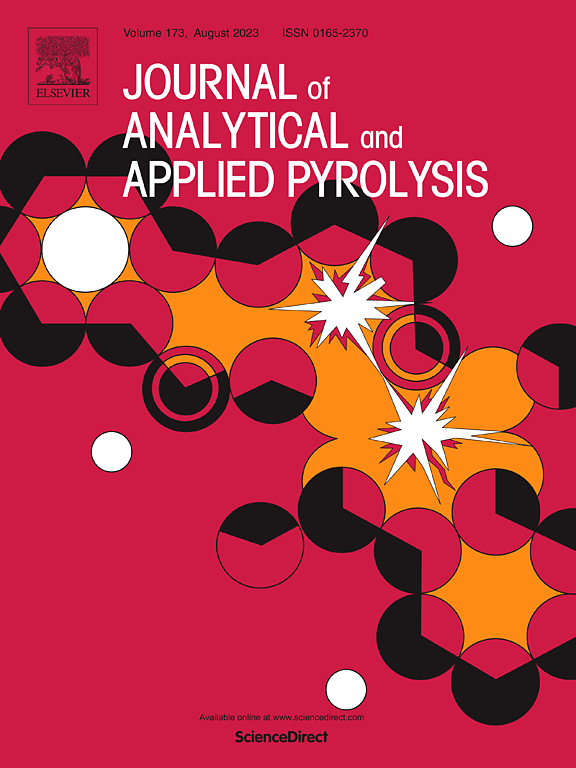Differences in pyrolysis behaviors of tar-rich coal macerals from various paleosedimentary environments
IF 5.8
2区 化学
Q1 CHEMISTRY, ANALYTICAL
引用次数: 0
Abstract
Tar-rich coal, a valuable resource for China's energy security, undergoes the production of tar and gas during pyrolysis. This study combines proximate and ultimate analyses with TGA and in-situ FTIR to investigate the molecular structure of raw coal and its macerals from three coal-forming environments. The results indicate that the paleosedimentary environment significantly affects coal structure, especially the aliphatic and aromatic structures, as well as oxygenated functional groups. Deeper overlying water and more reducing conditions foster the formation of aliphatic structures, which are abundant in vitrinite-rich concentrates and raw coal, whereas inertinite-rich concentrates contain fewer. During pyrolysis, aromatic C-H condensation results in the formation of semi-coke and coke. Raw coal and macerals from deeper, reducing environments decompose more rapidly, accelerating aromatic condensation. Additionally, volatile gases such as H₂, CO, CO₂, CH₄, and tar are generated during pyrolysis. CO and CO₂ mainly originate from the cracking of oxygenated functional groups. Xinjiang raw coal(T1-R(V)), formed under deep overlying water, exhibits intense decomposition due to the high content of oxygenated functional groups in aliphatic side chains. Xiwan coal(T3), from a wet forest swamp environment, has numerous oxygenated groups, leading to higher decomposition rates in raw coal and inertinite-rich concentrates. Aliphatic cracking releases hydrocarbon gases and tar, with faster decomposition occurring in deeper, reducing environments. The thermal decomposition rates of vitrinite-rich concentrates show minimal variation. These findings underscore the influence of coal-forming environments on pyrolysis, facilitating the efficient utilization of tar-rich coal.
不同古沉积环境富焦油煤显微体热解行为差异
富含焦油的煤是中国能源安全的宝贵资源,在热解过程中会产生焦油和天然气。本研究将近似值和极值分析结合热重分析和原位傅立叶变换红外(FTIR),研究了三种成煤环境中原煤及其矿物的分子结构。结果表明,古沉积环境对煤的结构影响显著,尤其是脂肪族、芳香族结构和含氧官能团。较深的上覆水和较强的还原条件有利于脂肪族结构的形成,脂肪族结构在富镜质组富集物和原煤中丰富,而富惰质组富集物较少。热解过程中,芳香族C-H缩聚生成半焦和焦炭。原煤和矿物从更深,还原环境分解更快,加速芳香凝聚。此外,热解过程中还会产生H₂、CO、CO₂、CH₄和焦油等挥发性气体。CO和CO₂主要来源于含氧官能团的裂解。新疆原煤(T1-R(V))在深上覆水中形成,由于脂肪侧链含氧官能团含量高,分解剧烈。西湾煤(T3)来自潮湿的森林沼泽环境,含氧基团较多,在原煤和富惰铁矿精矿中分解速率较高。脂肪族裂解会释放碳氢化合物气体和焦油,在更深的还原环境中分解得更快。富镜质组精矿的热分解速率变化不大。这些发现强调了成煤环境对热解的影响,促进了富焦油煤的高效利用。
本文章由计算机程序翻译,如有差异,请以英文原文为准。
求助全文
约1分钟内获得全文
求助全文
来源期刊
CiteScore
9.10
自引率
11.70%
发文量
340
审稿时长
44 days
期刊介绍:
The Journal of Analytical and Applied Pyrolysis (JAAP) is devoted to the publication of papers dealing with innovative applications of pyrolysis processes, the characterization of products related to pyrolysis reactions, and investigations of reaction mechanism. To be considered by JAAP, a manuscript should present significant progress in these topics. The novelty must be satisfactorily argued in the cover letter. A manuscript with a cover letter to the editor not addressing the novelty is likely to be rejected without review.

 求助内容:
求助内容: 应助结果提醒方式:
应助结果提醒方式:


